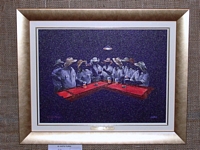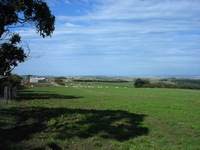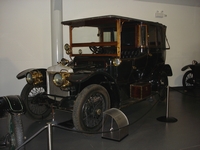Australia So Much to See



At Bordertown, there is unique colony of white kangaroos in the wildlife park. These are not albinos. In 1980 a large
white kangaroo (Western Grey species) was captured on a property and brought to the park. He went on to become the founding father
of the white kangaroo colony that has grown to become a tourist feature.
Bordertown is the birthplace of former Prime Minister Bob Hawke. Hawke memorabilia is on display in the
Civic Centre foyer.
Around Bordertown there area number of ‘runaway holes’. These holes fill with water in winter,
and the water rapidly finds its way through underground limestone channels to recharge the underground water. In summer, the
water suddenly drains away.
Taking a rural loop drive east of Naracoorte, an old shearing shed had eight stands
and was probably a community shed, used by a number of adjacent farms. Not far away was Weise’s Horse Dip – a remnant concrete
and wood dip which local horses from the area were walked through and had the dip bailed over them to eliminate external parasites.
At Naracoorte we visited the World Heritage listed Naracoorte
The caves record the Holocene and
the mid-late Pleistocene period, a fossil record spanning at least 500,000 years. It is during the late Pleistocene that
This giant kangaroo
like animal is one of many believed to have dropped to its death into the cave.
A large marsupial ‘lion’ has been reconstructed.
Heading towards Keith, we found an ideal camp site in an old gravel pit surrounded by bush. We did not know it was a cold and frosty night until we got up and found frost has formed inside the four seasons and shower vents. Frost remained on the car windscreen in full sun.
Travelling from Keith to Tailem Bend, where we crossed the Murray River by ferry, and drove through dairy farms
to the edge of
Following a track
we came to an isolated peninsula and parked on the cliff top. We looked east to the Narrung Peninsula in the distance, where
we had stopped on our way across to
A track led to a lower level, and a car came and a man set up a tent
with his family, but as it became windy, he packed up and went away. We stayed on top of the cliffs and watched the windy
sky at sunset.
Next morning I woke early because of a strange red glow. The wind was bringing the clouds in from
the east, and the start of sunrise was very colourful. I spent the half hour or so wandering around the edge of the cliffs enjoying
the changing colours of the sky and the water, and watching the water birds flying in to land on the lake, until the sun broke through.
We
called in at a lovely small settlement called Clayton with big new homes overlooking the water. There were plenty of building
lots for sale.
It was almost surrounded by channels of water, and we looked across to a farm on
Boats were moored in the small marina.
Goolwa is a very large and spread out town. We crossed on the
Large apartment complexes lined some of the artificially made
waterways. Along other canals, numerous houses were being built. There are over 1,000 lots being created. It covers
a considerable area, and we found it all rather ugly.
Further along through farmland and small settlements, we reached
the Mouth of the
Here there is a small opening to the ocean, and dredging of the channel is taking place on an
ongoing basis. Fresh water is maintained in the Lakes for irrigation by a series of barrages, and as no water has been
released for many years, the mouth is silting up. Closure would be disastrous for the birds and fish of the Coorong.
From
Goolwa, the coastline is a continuation of towns Middleton, Port Elliott,
Looking
back from Rosetta Head to Yilki,
Beyond this bluff, farms run to the coastal cliffs then it becomes
conservation park.
We drove along the
At
We continued up the western side of the peninsula.
Early morning at the
beach at
We spent the day at Wilunga to catch up with my friend from primary schools days, who came to the lovely
town from
We travelled through Strathalbyn and

At Birdwood we went to the
A steam driven early car.
Tom Kruze’s mail truck as seen on a television story about the restoration of the truck,
andTom’s life as an outback mail man.
We headed north, skirting the
Continuing
on, we stopped for the night at the Burra Creek Gorge – not so much a gorge as a creek line with large shady trees and plenty of camping
space all along the creek line.
On stopping, we discovered that a tyre had ‘peeled’ – this must be what the passing motorists
saw, and we must have stopped with the peeling section down when we checked. A large section had peeled off, but the tyre still
retained full pressure – it was not flat.
An old farm near Burra Creek Gorge in the early morning light. From Burra we
headed further north, passing large Merino studs, in particular in the Whyte Yacowie area.
In the old town of
During World War II, Terowie was home for a military camp. It was here that General Douglas McArthur uttered those famous words,
“I came out of
When we arrived back in
The Judges choice was a clever painting by Keith Blake of men drinking at a
bar – the clothes and glasses are painted on the dark background, but not the people; however the illusion is there – you can ‘see’
expressions on the faces that aren’t really there at all, and muscles on the arms resting on the bar.
A novelty piece by Don Gangell called The Redback on the Toilet Seat.
Many paintings depicted the soft beauty and colours
of the nearby


